OK, “torture test” might be overstating things just a bit, but I’ve been meaning to check out a few things related to the capabilities of the autofocus system of my new Canon EOS 5DS R. A few years ago birds, especially winter migratory birds, became one of my photographic passions. While this camera is not really optimized for this sort of photography, I plan to use it for this purpose, as I did my 5DII.
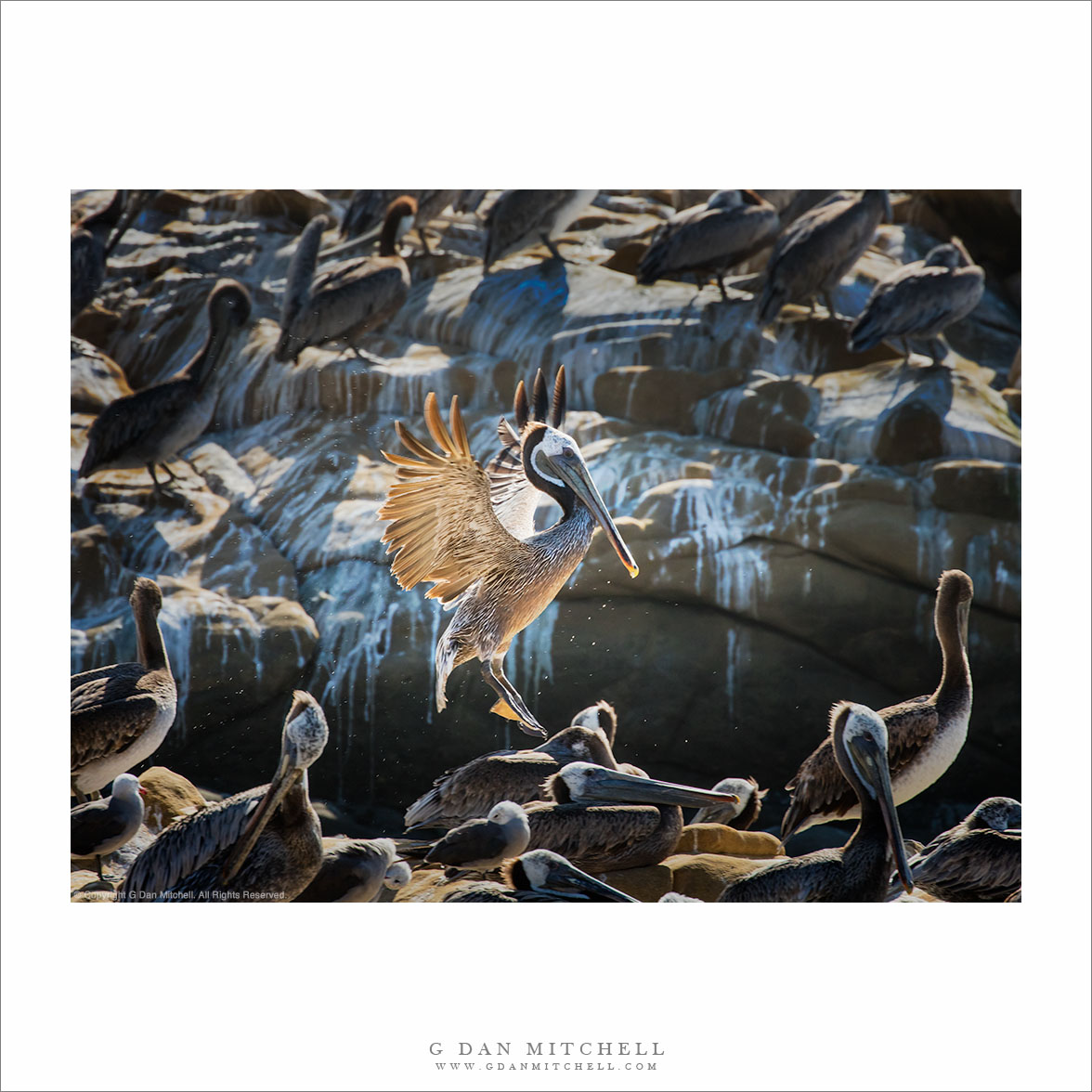
Most often when I photograph birds I use the Canon EF 100-400mm f/4.5-5.6L IS II lens. It usually provides enough reach for my purposes, it focuses accurately and quite quickly, it is sharp, and its flexibility fits my style of photography. (I often pause while photographing the birds and use the lens to photograph landscapes.) It was my understanding that the 5Ds R added the capability to autofocus (AF) at smaller apertures down to f/8. This means that I should be able to add my Canon Extender EF 1.4x III tele-extender to get 560mm at f/8 from this lens.
A few days ago I was doing landscape/seascape photography along the Central California coast between lower Big Sur and San Francisco. On the final afternoon as we drove north we passed a small island where scores of brown pelicans had landed.
With that opportunity at hand, I had my excuse to find out what this rig will do.
The lighting was challenging, with the sun and bright water behind the birds and the island on which they had assembled. This meant that some of the landed birds were in full shadow with backlight. Those in the sun were against a harsh and bright background of bright surf. (This also required a considerable “push” of the shaded side of the birds in post.) As a result I don’t regard all of these as great bird photographs. However, they do provide a “first look” at how the 5Ds R may work with this lens and the TC.
For bird photography the more ideal gear might use a camera with faster burst mode shooting — the 5Ds R is limited to about 5 frames per second (fps), while other cameras can operate at more than twice that rate. The AF system of the camera is said to have been improved over the earlier 5D models, with greater accuracy and speed and more options… and the ability to AF at f/8.
Two of the four photographs I’ll share here were selected because they both include birds that are headed directly or almost directly toward my camera position. This adds a certain autofocus challenge, as the camera has to more-or-less predict where the bird will be at the time of the exposure. (If the bird is stationary of flying from right to left the distance doesn’t change.) I set the camera to burst mode and used AI servo focusing with a cluster of focus points in the center of the frame. The third photo — the first one shown in the thread — is included because… I like it!
Because of the motion of the birds and the fact their shaded sides were facing me, I chose to set the camera to ISO 800. This let me shoot at f/11 (slightly more forgiving depth of field) and keep shutter speeds up around 1/2000 second. The first and second photographs presented earlier in this post were shot with the zoom ring at 400mm, which provided a 560mm focal length with the teleconverter attached.
I’ll share two versions of the following photograph. The first is the actual photograph, cropped somewhat from the full frame original. For this photograph I had to reduce the zoom a bit, giving an actual focal length of 463mm. (Images are slightly downsized by this website, so click the images to see the original 600 x 450 pixel size.)
As wrote, not a great pelican photograph — but a decent test. Not only was the bird heading toward me at this point, but it also passed directly in front of the rocks. This is also an AF challenge, as cameras will often get “confused” about which subject to focus on — more likely here with the matching colors and tones of rocks and bird. As you can see the camera did a fine job of managing to track the bird anyway.
Here is a 100% magnification crop of the bird and a bit of its lower wing.
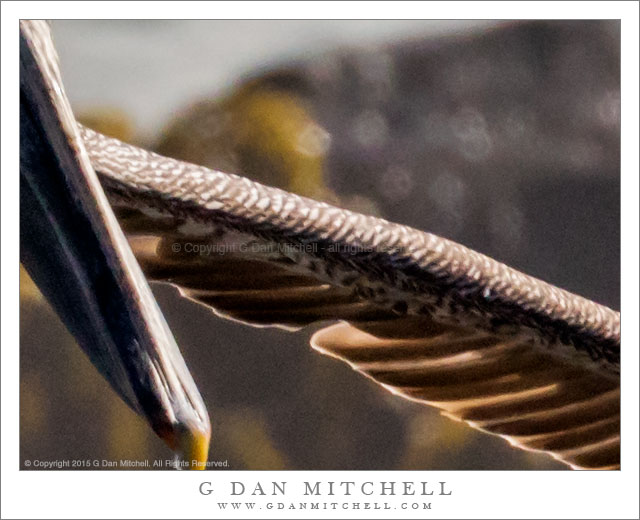
Finally, one more example, this one of a pelican in flight, banking into the wind before approaching the rocks where it would land. This one was also shot at 560mm with the 100-400mm lens plus the 1.4x extender. The original photograph was in landscape (wide and short) orientation, and I cropped away perhaps half of the image area to create this portrait orientation photograph.
Here is a 100% magnification crop of a section of the bird’s lower wing, just below its body.
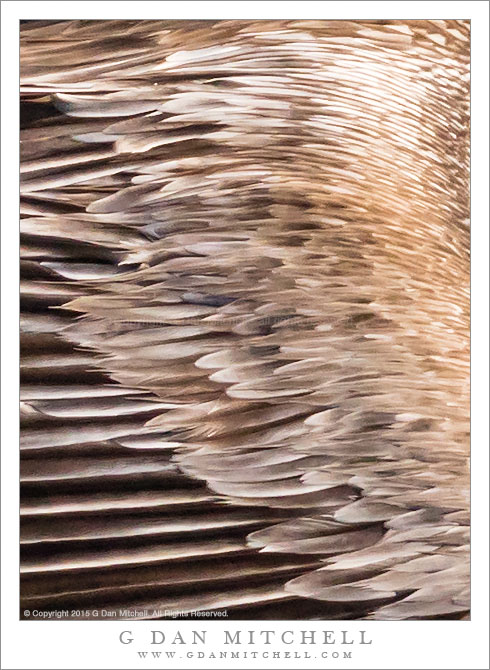
So, what does this mean? The answer requires some context. First, the camera seems to have done a fine job of tracking the subject and acquiring focus on (most likely) the bright area of the bird’s beak. Second, the sharpness appears to be a bit soft — but here is where context is important. Using a lower MP camera and eschewing the teleconverter would likely result in a sharper image. However, when we keep in mind that we are looking at 100% magnification crops from 50.6MP images, things seem a bit more positive, especially in the last example. These cropped sections from the full images would be about two inches along their long sides in a 30″ wide print — and would look quite sharp.
What conclusions can I draw from this initial quick test?
- The 5Ds R and 5DS autofocus system seems to be quite accurate, even with a challenging subject like this approaching pelican.
- These cameras do work effectively with the 1.4x teleconverter, potentially extending the reach of lenses you might use with the camera.
- The 100-400mm f/4.5-f/5.6L IS II lens performs well, even with the TC attached.
- While the 100% crop from the combination of 5Ds R, 100-400mm lens, and 1.4x TC is less sharp than, say, the 100-400 alone or a longer telephoto prime, the image quality can be quite good.
5Ds and 5Ds R Articles:
- The Canon EOS 5Ds R — Autofocus Torture Test
- The Canon EOS 5Ds R — Dynamic Range Examples
- The Canon EOS 5Ds R — A Resolution Example
- Canon 5DS R: A Printing Test
- Looking at Canon 5Ds RAW Files: Noise and Dynamic Range.
- Canon EOS 5Ds and 5Ds R Release Near?
- Canon 5Ds and 5Ds R Pre-orders Available
G Dan Mitchell is a California photographer and visual opportunist. His book, “California’s Fall Color: A Photographer’s Guide to Autumn in the Sierra” (Heyday Books) is available directly from him.
G Dan Mitchell: Blog | Bluesky | Mastodon | Substack Notes | Flickr | Email
All media © Copyright G Dan Mitchell and others as indicated. Any use requires advance permission from G Dan Mitchell.
Discover more from G Dan Mitchell Photography
Subscribe to get the latest posts sent to your email.

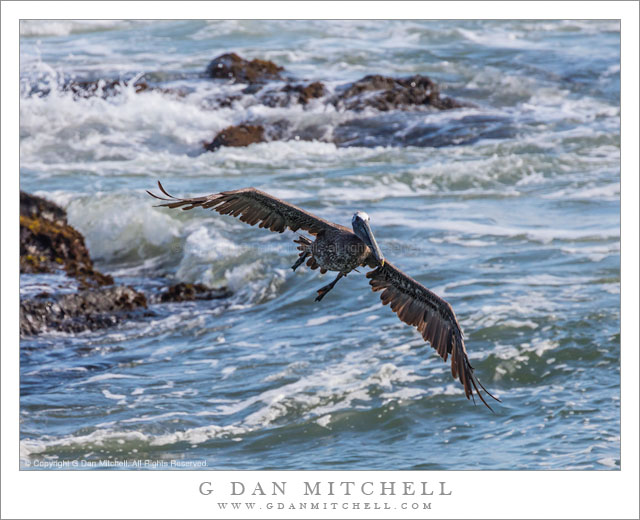
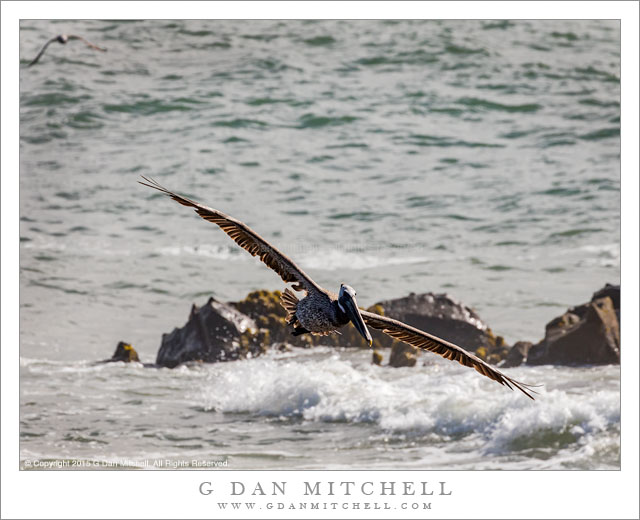
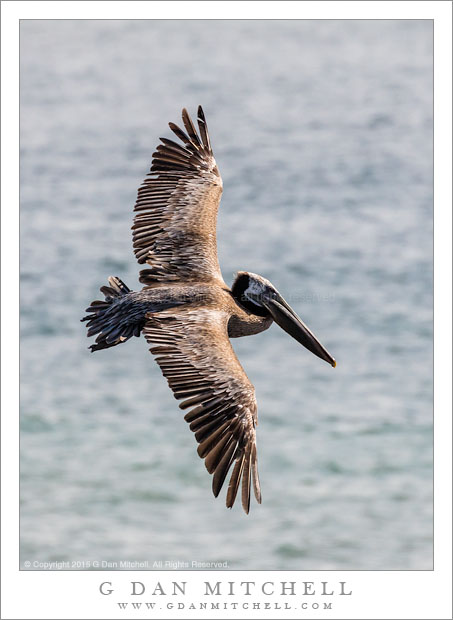
Yes, it is more of a visual guide than an actual crop. So if you, for example, set the square crop option… the camera captures the full 3:2 50MP image but you have the ability to see what a centered crop would look like before you photograph… and your post-processing software may default to using that crop.
As I mentioned, I do use the 4:3 ratio display crop for landscape photography. This makes a lot of sense in that my default aspect ratio for landscape is, in fact, 4:3… and because I use live view for composing and manually focusing when photography landscapes. This gives me a more precise sense of what that crop will look like.
When working quickly — for example photographing birds in flight or shooting street — I simply frame for the full image area and don’t take the time to worry too much about perfect framing in the way I do with landscape. (There are exceptions, but this is generally the case.)
Also, for me, when I put a particular lens on the camera I tend to to “see with that lens” as I’m photographing. This is especially so when I shoot street, which I usually do with a non-Canon system and using primes. So it would be a bit unusual for me to have, say, a 35mm lens on the camera and want to shoot as if I were using 45mm… and need to know the framing precisely.
In any case, cameras are so advanced now that they offer configuration options to please just about every photographer!
Hi Dan
You have got me all excited about the 5ds r. All your photos are so great. I am drooling over them.
I have been on B&H Photos Notify When Available List for a few weeks now, every couple of weeks I get an email saying still not available. Sure hope I can get one as I am on the West Coast.
I would probably never stop crying if I woke up and had an email they where available, then found out the Guys and Gals on the East Coast had orderd all B&H had in stock while I was still asleep.
I downloaded the manual yesterday, having a lot of fun reading up on the 5ds r. I should have thought to do that when I got on the Notify When Available List.
Norm
The 5DsR is still a very capable camera. I continue to use mine and while I’ll move on eventually, I’m in no hurry!
Have you tried the crop function on the 5Ds R
1.3x crops are 30 megapixels (6,768 x 4,512) and 1.6x (APS-C) crops are 19 megapixels (5,424 x 3,616).
If so how do those lower megapixels photos campare to using the extender and the full 50 megapixels?
Hi Norman,
I have not used those options, primarily for practical reasons. Often when shooting a subject that might end up getting cropped, I am in the middle of shooting other photographs in which I’ll end up using the entire frame. So switching in and out of different cropping modes would probably interfere in the flow of the photography in most cases. Plus, if I capture the entire frame I can sill crop in post.
I’d have to check and see precisely how the 5DsR handles the crops you mention. I do use the 4:3 aspect ratio setting, which does crop the image on the rear display. However, at least when shooting in raw (as I always do) the camera is actually still capturing the full 50MP image — it just defaults to cropping it to a smaller size in post. But I can still “un-crop” in in post and get the full 3:2 image.
In a more general sense, you can still get some very good images by cropping smaller from the full image. I do not shy away from doing that when necessary, as it often is with birds.
If I know that I need more reach, in many situations I prefer to add the 1.4x TC. That might give up a little bit of sharpness, but it is hardly noticeable and image quality is still excellent — plus I get the range of potential advantages from the 50MP file. (One downside is that you look AF points on the 5DsR with the TC and some of the longer lenses, such as my 100-400mm v.2.)
Dan
Hi Dan
You might find this review helpfull. https://www.kenrockwell.com/canon/5ds.htm
Copy and Paste from the review: “As-Shot, In-Finder Cropping I set my M-Fn button so that each tap gives me a different crop, and my finder grays-out its edges to let me see my exact crop. (You can change the finder to show just a frameline instead of all-gray edges.)
Each tap selects Canon’s old-standard 1.3x crop, the APS-C 1.6x crop or a square 24 x 24mm crop.
I crop on the fly without taking my eye from the finder. This is especially useful when shooting with a fixed lens. I LOVE this feature. For instance, with my EF 35mm f/1.4 L, I get my full 35mm f/1.4; the next tap gives me the equivalent of a 45mm f/1.4, then a 55mm f/1.4, and finally a square crop, all as seen through the finder.”
I have added a couple of additional photographs to this article.The first is simply one that I think is interesting on photographic merits, and the second shows a 100% magnification crop of feathers and crops the original image quite a bit